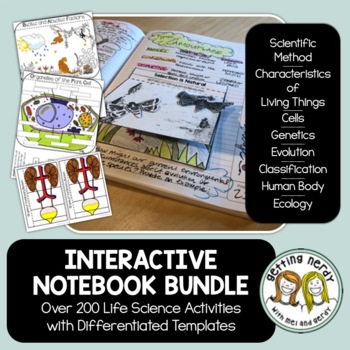Science Interactive Notebook Bundle - Life Science and Biology
- Zip
- Google Apps™

What educators are saying
Products in this Bundle (10)
showing 1-5 of 10 products
Description
Engage your students with over 200 Interactive Notebook activities in digital google and regular format for all of your life science needs. Our interactive notebook flippers will have your kids "flipping" their way to learning all about cells, genetics, evolution and more! Use these activities as stand-alone lessons or as a supplement to our Curriculum Bundle.
WHAT'S INCLUDED in this YEAR-LONG BUNDLE:
• SEVEN Life Science Interactive Notebook Units and THREE supplemental packs including over 200 differentiated templates in blackline and color:
→ Cells and Cell Processes DIGITAL GOOGLE CLASSROOM VERSION COMPLETED
→ Scientific Method and the Nature of Science
→ Genetics and Heredity
→ Evolution
→ Classification
→ Human Body Systems
→ Ecology and Ecosystems DIGITAL GOOGLE CLASSROOM VERSION COMPLETED
→ Introducing Interactive Notebooks
→ Back to School activities
→ End of Year activities
• Directions for each activity
• Answer keys
• Photographs of each activity from our INB
STUDENTS WILL:
• Cut out, color and answer questions on the assigned templates
THIS PRODUCT IS ALSO FOUND IN OUR:
• Life Science Supplemental - Interactive Notebook, Word Wall, Task Card Bundle
SEE HOW THIS LESSON ALIGNS WITH THE NGSS, TEKS or GSE
Because we have created many of our own graphics or have purchased licenses to other graphics with permission, we cannot offer our resources in editable format unless otherwise stated.
TERMS OF USE (TOU):
All rights reserved by GETTING NERDY®️
• This product is to be used by the original purchaser only
• Intended for classroom and personal use only
• Copying for more than one teacher, classroom, department, school, or school system is prohibited
• This product may not be distributed or displayed digitally for public view
Failure to comply is a copyright infringement and a violation of the Digital Millennium Copyright Act (DMCA). Clipart and elements found in this PDF are copyrighted and cannot be extracted and used outside of this file without permission or license.
Life Science and Biology Interactive Notebook Bundle © 2012 to present Getting Nerdy ®️ All Rights Reserved





